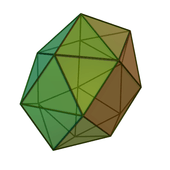Snub square antiprism
From Wikipedia, the free encyclopedia
| Snub square antiprism | |
|---|---|
 | |
| Type |
Johnson J84 - J85 - J86 |
| Faces |
8+16 triangles 2 squares |
| Edges | 40 |
| Vertices | 16 |
| Vertex configuration |
8(35) 8(34.4) |
| Symmetry group | D4d |
| Dual polyhedron | - |
| Properties | convex |
| Net | |
 | |
In geometry, the snub square antiprism is one of the Johnson solids (J85).
A Johnson solid is one of 92 strictly convex regular-faced polyhedra, but which is not uniform, i.e., not a Platonic solid, Archimedean solid, prism or antiprism. They are named by Norman Johnson who first enumerated the set in 1966.
It is one of the elementary Johnson solids that do not arise from "cut and paste" manipulations of the Platonic and Archimedean solids, although it is a relative of the icosahedron that has fourfold symmetry instead of threefold.
It can be thought of as a square antiprism with a chain of triangles inserted around the middle. A similar effect can be achieved with a triangular antiprism (which is an octahedron), resulting in an icosahedron.
External links
This article is issued from Wikipedia. The text is available under the Creative Commons Attribution/Share Alike; additional terms may apply for the media files.